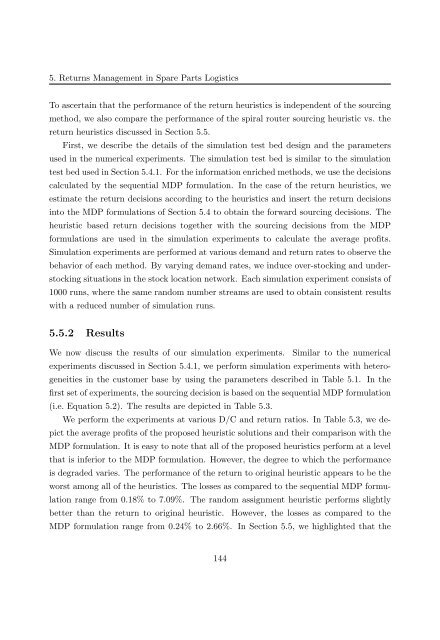Customer Information Driven After Sales Service ... - RePub
Customer Information Driven After Sales Service ... - RePub
Customer Information Driven After Sales Service ... - RePub
Create successful ePaper yourself
Turn your PDF publications into a flip-book with our unique Google optimized e-Paper software.
5. Returns Management in Spare Parts Logistics<br />
To ascertain that the performance of the return heuristics is independent of the sourcing<br />
method, we also compare the performance of the spiral router sourcing heuristic vs. the<br />
return heuristics discussed in Section 5.5.<br />
First, we describe the details of the simulation test bed design and the parameters<br />
used in the numerical experiments. The simulation test bed is similar to the simulation<br />
test bed used in Section 5.4.1. For the information enriched methods, we use the decisions<br />
calculated by the sequential MDP formulation. In the case of the return heuristics, we<br />
estimate the return decisions according to the heuristics and insert the return decisions<br />
into the MDP formulations of Section 5.4 to obtain the forward sourcing decisions. The<br />
heuristic based return decisions together with the sourcing decisions from the MDP<br />
formulations are used in the simulation experiments to calculate the average profits.<br />
Simulation experiments are performed at various demand and return rates to observe the<br />
behavior of each method. By varying demand rates, we induce over-stocking and understocking<br />
situations in the stock location network. Each simulation experiment consists of<br />
1000 runs, where the same random number streams are used to obtain consistent results<br />
with a reduced number of simulation runs.<br />
5.5.2 Results<br />
We now discuss the results of our simulation experiments. Similar to the numerical<br />
experiments discussed in Section 5.4.1, we perform simulation experiments with heterogeneities<br />
in the customer base by using the parameters described in Table 5.1. In the<br />
first set of experiments, the sourcing decision is based on the sequential MDP formulation<br />
(i.e. Equation 5.2). The results are depicted in Table 5.3.<br />
We perform the experiments at various D/C and return ratios. In Table 5.3, we depict<br />
the average profits of the proposed heuristic solutions and their comparison with the<br />
MDP formulation. It is easy to note that all of the proposed heuristics perform at a level<br />
that is inferior to the MDP formulation. However, the degree to which the performance<br />
is degraded varies. The performance of the return to original heuristic appears to be the<br />
worst among all of the heuristics. The losses as compared to the sequential MDP formulation<br />
range from 0.18% to 7.09%. The random assignment heuristic performs slightly<br />
better than the return to original heuristic. However, the losses as compared to the<br />
MDP formulation range from 0.24% to 2.66%. In Section 5.5, we highlighted that the<br />
144

















